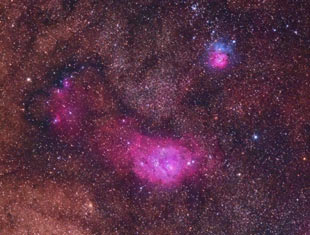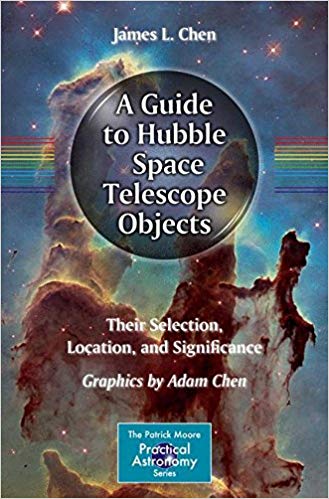As the last glimpses of the summer Sagittarius constellation gives way to the autumn deep sky delights, we still will have a chance to view one of the classic Messier objects to observe, the Trifid Nebula M20.
The Trifid Nebula was discovered by Charles Messier on June 5, 1764.
The Trifid Nebula, in the constellation Sagittarius, is a fun object to observe, since it is a combination of an emission nebula, a reflection nebula, and a dark nebula. (see NASA Hubble figure below)

The name Trifid means “divided into three lobes”. For those readers who are hopping around this book, here are some of the historic details you may have missed:
Charles Messier wrote:
“June 5, 1764. 20. 17h 48m 16s (267d 04′ 05″) -22d 59′ 10″
Cluster of stars, a little above the Ecliptic, between the bow of Sagittarius & the right foot of Ophiuchus. Seen again March 22, 1781.”
John Herschel was the first to use the term Trifid in describing M20, taken from his notes:
“Sweep 30 (July 1, 1826) RA 17h 51m 64.3s, NPD 113d 0m 6s (1830.0) vL; trifid, three nebulae with a vacuity in the midst, in which is centrally situated the double star Sh 379, neb == 7′ in extent. A most remarkable object. very large; trifid, three nebulae with a vacuity in the midst, in which is centrally situated the double star Sh 379, the nebula is 7′ in extent. A most remarkable object.”
M20 is an easy 2 degrees northwest of M8, the Lagoon Nebula. At magnitude 9, M20 does not reveal its details for binoculars and small telescopes. The true nature of M20 is revealed with an 8 inch or larger aperture telescope. Aperture is your friend in showing details of M20, especially Barnard 85, although a high quality apochromat refractor is quite capable for this object. Using either a UHC or O-III nebula filter is a great aid in observing the Trifid. (see M8 and M20 figure below)

Few backyard astronomers realize that M20’s dark lanes are catalogued as Barnard 85, from E.E. Barnard’s unique list of dark nebulae.. The dark nebula veins can be seen in a 5” apochromat refractor telescope at 65x-to-104x, and details appear more prominent with 8 inches or more aperture. Sharp eyed observers may grasp a hint of Barnard 85 using 4” telescopes with great optics on clear steady nights.
Edward Emerson (E.E.) Barnard was one of the greatest astronomers of the 19th century. His exceptional eyesight aided him in the discovery of the fifth moon of Jupiter, approximately thirty comets, and numerous bright and dark nebulae. In 1919, he published his initial catalog of dark nebulae in the Astrophysical Journal under the title “On the Dark Markings of the Sky with a Catalogue of 182 Objects.” The catalog eventually expanded to 370.
Astronomers have estimated the age of the Trifid Nebula to be approximately 300,000 years old, making it one of the youngest nebulae of its kind known.
The emission nebula portion of M20 is illuminated by the light of massive young hot class O stars that form the core of the emission nebula. The star cluster is partially obscured by the thick dust lanes of Barnard 85. Barnard 85 consists of dust clouds that absorb and block light from the bright star cluster behind them. It is responsible for the apparent gaps in the larger emission nebula that give M20 its trifurcated look.
The reflection nebula portion of M20 is not physically associated with the emission or dark nebula portions of the Trifid, and is in the line-of-sight to the Earth observers.
